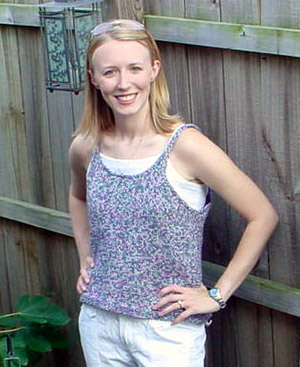 CO
30s[36s , 42s ,
48s ,
54s ]
[_____] sts.
CO
30s[36s , 42s ,
48s ,
54s ]
[_____] sts.
Place unique marker for
beginning of round [BOR].
Join in the round being careful not to twist.
Knit 15s [18s ,
21s ,
24s ,
27s ]
[_____] sts.
Place marker for middle of round [MOR].
Knit to BOR.
P 1 rnd, k 1 rnd, and
p 1 rnd for 4 rows of garter st.
Work even in St st until
piece measures 10[10, 12, 12, 14] inches
from beg.
Place half the stitches
[15s [18s, 21s , 24s , 27s ] [_____]]
on hold using a stitch holder, a second
circular knitting needle, or a length of
contrasting yarn.
Back
Shape armholes
[RS]
Working on the 15s[18s ,
21s ,
24s ,
27s ]
[_____] live stitches, BO at beg
of row over the next 6[10, 14, 18, 22] rows
a total of 3s [5s ,
7s ,
8s ,
10s ]
[_____] sts. 12s [13s ,
14s ,
16s ,
17s ]
[_____] sts rem.
Dec at both ends of needle
[SSK at beg, k2tog at end] over the next
8[8, 10, 10, 12] rows a total of 4s [4s ,
5s ,
5s ,
6s ]
[_____] sts. You will have 8s [9s , 9s , 11s ,
11s ]
[_____] sts remaining.
Work even until piece measures 12[14, 16,
18, 20] inches from beg, ending with a WS
row.
Shape neck
K 3s [3s ,
3s ,
4s ,
4s ]
[_____], join new yarn and BO center
2s [3s , 3s , 3s , 3s ] [_____] sts.
Work to end - you should have 3s [3s ,
3s ,
4s ,
4s ]
[_____] sts on each side.
Working each side separately,
BO 1s [1s ,
1s ,
1s ,
0s ]
[_____] sts at neck edge once, then
dec at each neck edge 1s [1s ,
1s ,
1s ,
2s ]
[_____] sts over the next 8 to 10
rows -- 1s [1s , 1s , 2s , 2s ] [_____] sts rem each side.
Work even until piece measures 16[18, 20,
22, 24] inches from beg.
Place all sts on hold, using either a large
safety pin or a stitch holder.
Front
Shape armholes
[RS]
BO at beg of row over the next 6[10, 14,
18, 22] rows a total of 3s[5s , 7s , 8s , 10s ]
[_____] sts. 12s [13s ,
14s ,
16s ,
17s ]
[_____] sts rem.
Dec at each end of needle
over the next 8[8, 10, 10, 12] rows a total
of 4s [4s , 5s , 5s , 6s ] [_____] sts. You will have 8s [9s , 9s , 11s ,
11s ]
[_____] sts rem.
Work even until piece measures 11[13, 14,
16, 18] inches from beg ending with a WS
row.
Shape neck
K 3s [3s ,
3s ,
4s 4s ]
[_____], join new yarn and BO center
2s [3s , 3s , 3s , 3s ] [_____] sts.
Work to end of row - you should have 3s [3s ,
3s ,
4s ,
4s ]
[_____] sts on each side.
Working each side separately,
BO 1s [1s ,
1s ,
1s ,
0s ]
[_____] sts at neck edge once, then
dec at each neck edge 1s [1s ,
1s ,
1s ,
2s ]
[_____] sts over the next 8 to 10
rows -- 1s [1s , 1s , 2s , 2s ] [_____] sts rem each side.
Work even until piece measures 16[18, 20,
22, 24] inches from beg.

